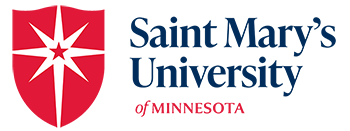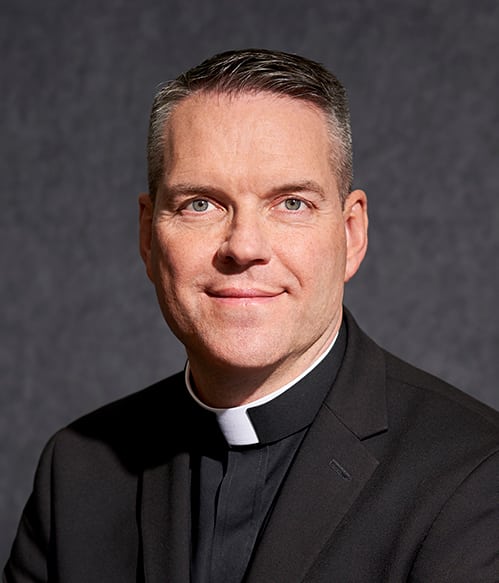Saint Mary's Newsroom
Campus ConnectionAn update from the president to alumni and parents
Is your social media ready for when the next crisis strikes? Let our experts help!
At the National Institute for Social Media, response plans are the priority. A response plan is the high-level look, or the umbrella overview, that crisis management falls under. Your response plan details how you respond to positive, negative feedback, and any neutral feedback that comes your way.
Take a compliment and make the most out of it:
Positive feedback feels like you’re off the hook. If feedback is all positive, you feel like you don’t have to do anything. But that’s your opportunity to nurture and strengthen those who are already your supporters. They then become your brand champions.
Avoid the neutral zone traps – react and respond accordingly:
Questions or posts that aren’t really positive or negative land in neutral space, and that’s really not crisis communication, responding to those is just good customer service.
When crisis strikes:
If you have a crisis, most people associate it with an isolated event, and sometimes you can plan for it, sometimes you can’t. A few years ago, when Nordstrom’s discontinued Ivanka Trump’s clothing line, they anticipated a negative backlash by those who would accuse them of being politically motivated. They stated sales was the reason, and 100 percent came out neutral, but they could anticipate that particular feedback.
Whereas, in the viral video of a passenger being physically dragged off an airplane, the airline couldn’t have anticipated that event. However, with an online response plan, they would have been prepared to respond to the unexpected event.
A quick response is important but an informed response is more important than anything else. If it fits the situation, you may buy yourself time to do a little research by commenting that you’ve passed their question on and will respond soon.
If you don’t have a strategic plan to fall back on, and you respond quickly but poorly, you run the risk of doing more harm than good. With an online response plan, people understand how to assess a given situation.
- Respond: To show transparency, we want everyone to see we are responding to customer; we have a planned response where we acknowledge the customer.
- Take offline: Give them an offline option for sharing additional information.
- Resolve: This allows the customer to have their issue resolved and be heard but discourages them from sharing ugly details on that highly visible platform.
The plan is for a social media manager to have a path when they don’t know what to do. The viral airplane video is one example because by the time their social media people saw it, it was already going viral. They had every indication they should be panicking. Did they have a person to talk to help them make the decision about how it needs to be addressed? For those crises we can’t anticipate, there needs to be a clear path to a leader who can help with this difficult situation.
One of my favorite things to tell people is that you don’t have to be victimized online just because you’re a professional organization. You can set up community guidelines. Some businesses think, what if someone starts using racial slurs or inappropriate comments? You can post community guidelines that state these are our expectations of how our customers can participate respectfully, and we reserve the right to delete your content. You can set the expectation that you want people to engage respectfully.
You have to get to the heart of what people are really asking or wanting. In the case of Ivanka Trump’s clothing line, nobody was upset because Nordstrom’s wasn’t carrying the clothing line; what they were really upset about was that a large organization could be taking a political stance against the at-that-time republican candidate.
Are you looking to know more about how corporations and institutions need to be prepared and how they need to react when bad news goes viral? That’s where we can help.
Amy Jauman, Ed.D., is social media expert, consultant, writer, and professor at Saint Mary’s University of Minnesota. Dr. Jauman authored a (National Institute for Social Media) NISM textbook for social media strategists and is available to speak to speak with media — simply click on her icon to arrange an interview.
Connect with:
 Amy Jauman, Ed.D.
Amy Jauman, Ed.D.
Associate Professor, Master of Business Administration
Expertise: Coaching and Adult Education
View profile
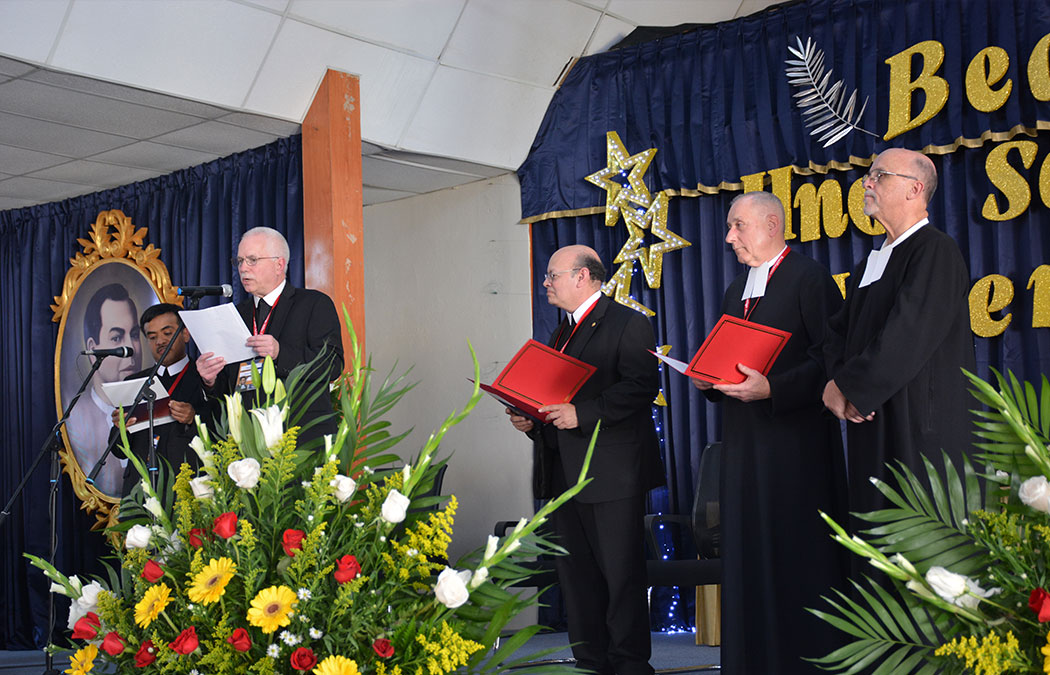
Saint Mary’s presents Signum Fidei Awards to De La Salle Christian Brother Districts
On Dec. 7, Saint Mary’s University presented Signum Fidei Awards to two districts of De La Salle Christian Brothers, in coordination with and in honor of Blessed Brother James Miller’s beatification ceremony that day in Guatemala.
Signum Fidei Awards were given to De La Salle Christian Brothers Michael Ferhenbach, FSC, Visitor, Midwest District, and Alberto Mairena Floripe, FSC, Visitor, Central America-Panama District, in recognition of Brother James’ ministry in both the Midwest and Central American provinces.
Brother James Miller, who earned his graduate and undergraduate degrees from Saint Mary’s in 1966 and 1974, was only 37 when he was shot and killed as he was mending a wall outside a school where he worked in Huehuetenango, Guatemala, in 1982. It is suspected that Brother James was killed because he and the other De La Salle Christian Brothers fought to keep their young students from being forced into the military. He is the only Christian Brother from the U.S. to have been beatified.
The Signum Fidei Award was established by the university as a way to honor the life and work of Brother James. It is bestowed on an individual, group, or organization in recognition of extraordinary service to the vulnerable and marginalized members of society. It also recognizes and honors work that promotes human solidarity. Its name, signum fidei (or “sign of faith”), is taken from the great seal of our Lasallian family, the Institute of the Brothers of the Christian Schools.
The Signum Fidei Award is the university’s most prestigious award and has been presented only two previous times. It was first awarded in September 2014 to the Bishop (now Cardinal) of Huehuetenango (the place of Brother James Miller’s death), Álvaro Leonel Ramazzini Imeri. The second was to Pope Francis, given at St. Peter’s Square in Vatican City in April 2015.
The award itself is a miniature bronze bust of Brother James atop a piece of limestone that was quarried in Winona. The bust is a replica, prepared by Minnesota artist Alec M. Smith, of the life-sized memorial to Brother James that was installed at the entrance of Residencia Santiago Miller, a student residence hall on the Winona Campus, and was dedicated during the university’s centennial celebration in 2013.
The fact that the same casting of the life-size bust will now have a second permanent home at the center where Brother James gave his life connects and unites Saint Mary’s and Casa Indígena Santiago Miller in a special way.
To learn more about Brother James, go to smumn.edu/brotherjames.

Marketing class provides ad campaign ideas for Winona YMCA’s future facility
In the past, the students in the MK372 Advertising and Promotions class on the Winona Campus would select a product that interested them and then reconceive a new ad campaign around that product throughout the course of the semester.
This year, though, with the Winona Family YMCA’s new facility on the horizon, Professor Shelly McCallum-Ferguson, D.B.A., decided to try something new by working with an actual external group. This past summer, Dr. McCallum reached out to Tesla Mitchell ’12, the marketing and communications coordinator at the Winona Family YMCA, about a possible collaboration.

The marketing class was divided into four teams, who were presented campaigns based off of four different demographics. Above is a proposed social media ad created by the team, who were assigned with the demographic of adults who are between the ages of 18 and 30.
“I was thinking this year that it might be fun to work with the YMCA, because of the new build going on in town,” Dr. McCallum said. “There has been a fair bit of chatter about it in town, and it was just a nice connection because of Tesla being a Saint Mary’s alumna.”
At the beginning of the semester, Mitchell, who earned a degree in journalism from Saint Mary’s, presented the class with marketing information on four types of key demographics for the YMCA: adults ages 18-30, families, adults 62 and older, and corporate memberships.
On Nov. 26, the class members, most of whom are junior or senior marketing majors in the School of Business and Technology, presented the creatives — either for radio, TV, billboards, traditional print, brochures, or social media — and made their pitches as if they were members of an ad agency to Mitchell and Janneke Sobeck, the CEO of the Winona Family YMCA.
Hailey Nisbit is a senior in the class from St. Charles, Minn., who will complete a double major in marketing and sport management at the end of the fall semester.
“It was a really good experience to just work with a third party and really understand and listen to what exactly it is that they’re wanting,” Nisbit said. “By being assigned to a specific target market, we could hone in and do more research in that one area.”

Above is a proposed billboard created by the team who were assigned with the “families” demographic.
Nisbit was in the group assigned to the “families” demographic — a task that proved to be a bit of a challenge given that none of the students have young families themselves. She and her team did research on comparable gyms, while gathering additional insight through word-of-mouth interactions. In the end, her team presented a billboard sign, a radio ad, and a TV ad.
“Overall, it was a really great experience that we can use in the future when we’re going in our own careers,” said Nisbit.
Mitchell was impressed with how closely the students followed the YMCA’s extensive brand requirements.
“They had some unique ideas that we had not thought about,” Mitchell said. “So the CEO and myself definitely walked away feeling revitalized and energized about our campaign for the new YMCA — and definitely had some ideas to consider.”
Mitchell added that several of the ideas could be implemented into the actual ad campaign for the new facility, which is scheduled to open next October and is located next to Winona Health. The campaign is scheduled to start after the new year and ramp up its efforts in the summertime. The new venue will replace the current building at 207 Winona St., which first opened its doors in March of 1886.
“It was a win-win for both sides,” said Dr. McCallum, who, going forward, hopes to continue to providing students in this course with real-life experiences with external businesses and organizations.
Featured image: Members of the MK372 Advertising and Promotions class take a photo with Winona Family YMCA Marketing and Communications Coordinator Tesla Mitchell (middle, front row) and CEO Janneke Sobeck (right of Mitchell). Dr. Shelly McCallum-Ferguson, who teaches the class, is on the far left.

Saint Mary’s doctoral student researching link between Parkinson’s disease and depression
For years, depression has been associated with cognitive difficulties. A Saint Mary’s doctoral student is the lead author on a study recently published in the Archives of Clinical Neuropsychology, which provides a new perspective.
“We don’t want to necessarily attribute depression as the cause of any kind of cognitive decline. It is very possible it’s playing a role, but we shouldn’t blame depression entirely,” said Blair Honsey M’17, who is a student in the Doctorate in Psychology in Counseling Psychology program at Saint Mary’s.
The paper examined the effect depression had on neuropsychological test performances conducted with subjects with early-stage Parkinson’s disease.
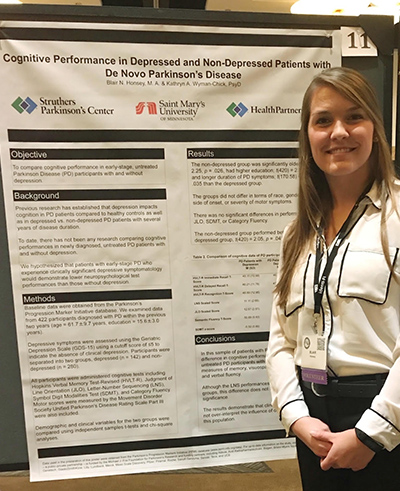
Blair Honsey M’17, poses next to the poster that she presented at the annual meeting of the National Academy of Neuropsychology in November in San Diego.
Honsey and the research team analyzed data from 422 participants who took part in the Parkinson’s Progression Marker Initiative (PPMI) using the Geriatric Depression Scale, known more commonly as the GDS-15, which is a set of 15 questions to assess the mental health of senior citizens based on a points system. The researchers used the scale to create two categories within the sample of patients with Parkinson’s disease: depressed (142 participants) and non-depressed (280 participants). Honsey and the study’s corresponding author, Kate Wyman, Psy.D., then ran a comparison of the cognitive data set of the two groups.
The only significant difference in cognitive function appeared when participants were tasked with a working memory test of remembering and reorganizing long sequences of numbers and letters. When looking at the entire data set, the findings suggest depression may play less of a causative role on cognitive loss, said Honsey, who presented a poster of her findings at the annual meeting of the National Academy of Neuropsychology in November in San Diego.
“It’s really common in neuropsychology for anyone who has depression or any kind of mental health issues to attribute some of their current decline to those mental health symptoms,” Honsey said, adding: “We do know that depression and anxiety definitely do have an effect on our cognition. However, our research is saying that we shouldn’t give those attributes a lot of credit, and to be aware when considering scores — and particularly early-stage Parkinson’s disease — that signs of depression don’t necessarily account for any kind of decline.”
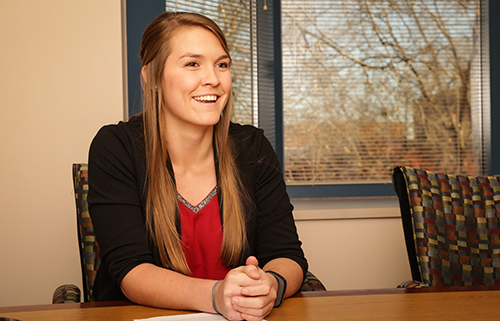
Blair Honsey M’17, is currently working on her third practicum as a doctoral student specializing in neuropsychology at Saint Mary’s.
The fact that the test results were not significantly different between the two groups of study participants surprised Honsey and her associates. Furthermore, when implementing the GDS-15 to create the two groups, it was a bit of a shock to see that the average score of the depressed group was a six; the non-depressed group, a four. A score of five or higher suggests depression.
“The non-depressed group was right up on the cusp of technically almost meeting that cutoff, which led us to think there are likely still some depressive symptoms in that group,” Honsey said. “So maybe the differences between the two groups weren’t different enough to determine a true effect in all of these different domains.”
‘This is going to be a sprint’
Honsey has been working with Wyman at HealthPartners Neuroscience Center in St. Paul since early spring as part of her third practicum in the neuropsychology field. The two first met through a mutual contact at Hennepin County Medical Center, where Honsey did her second practicum — and fell in love with the field of neuropsychology in general.
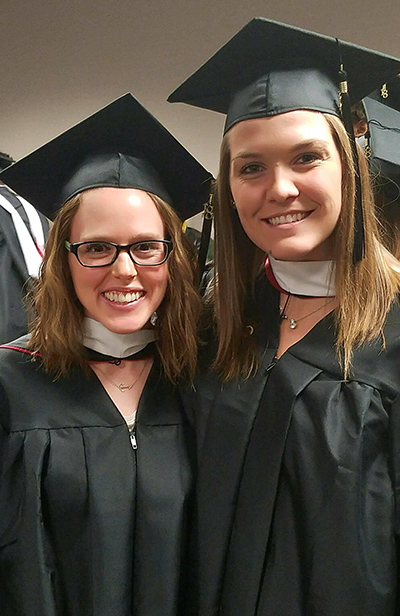
Blair Honsey M’17, with a fellow classmate in the psychology program, Kendra Van Rossum M’17, at the commencement ceremony for the Master of Arts in Counseling and Psychological Services in 2017. The two are currently pursuing doctoral degrees from Saint Mary’s.
“I think it’s really interesting to watch and see so many different people approach the same task so differently,” Honsey said. “It’s fascinating to see how our brains function so differently, even when we’re given the exact same tools or questions or things to work with.”
As soon as Honsey found out about all the previous work that Wyman had done in the area of Parkinson’s disease — and her mentor’s familiarity and accessibility to the PPMI data set — she was determined to not only get a paper published but also present at the national conference in San Diego.
“She just really struck me as someone who was eager to learn,” Wyman said. “I told her, ‘This is going to be a sprint. If you if you want to accomplish this, I think we can do it, but it’s going to be a challenge.’”
Honsey was able to submit an abstract, conduct the research, get the paper published, and present a poster at the conference all in the span of six months.
“It’s pretty unusual for it to go that smoothly,” Wyman said.
As Honsey’s academic path has indicated, though, she has no issues with getting tasks done quickly without sacrificing quality.
The Stewartville, Minn., native earned a double major in psychology and criminology from the University of Minnesota in two years after completing all of her general education courses through a college credit program at her high school affiliated with Minnesota State University, Mankato.
Honsey initially planned only to pursue a Master of Arts in Counseling and Psychological Services at Saint Mary’s in 2015, but was then sold on earning a doctorate to have “all doors open,” in her words, when she embarked on her career after her time on the Twin Cities Campus.
“I didn’t want to enter the field with a master’s degree and then find out that I’m really passionate about something else within the field that later requires a doctorate,” she said.
From the beginning of her time at Saint Mary’s, she has valued the veracity and the accessibility her professors have provided. She recalled one professor saying at the start that if the students only wanted to do therapy, the doctorate degree was not a requirement.
“I really just appreciated the honesty of looking out for us,” Honsey said. “A lot of people in my program and my cohort did just want to do therapy, but they decided to be a part of this program so they can get that further education and be a better therapist.”
Starting out on a path
Honey’s first practicum took place at the Federal Medical Center in Rochester, where she worked with inmates. Her work there inspired her dissertation, which examines the results from a survey she conducted of approximately 580 Minnesotans over the age of 18 who answered questions to assess their attitudes of support for the reentry of criminal offenders.
“Blair is incredibly intellectually curious and self-motivated to learn,” said Daniel Holland, Ph.D.,
core professor in the program and Honsey’s faculty adviser. “Her appreciation of research as relevant for clinical work is the perspective we have been promoting in professional psychology for a long time, so to see Blair exemplify this at such an early stage of her professional development is inspiring for everyone.”
In addition to helping Wyman interview patients and conduct tests similar to those done as part of the PPMI at HealthPartners, Honsey also spends half of the week working as a senior forensic psychometrist at the Hennepin County Government Center in downtown Minneapolis, where she conducts psychological tests on people who are about to stand trial. She is in the process of applying for a year-long clinical neuropsychology training internship at a hospital or Veterans Administration facility, before finishing her degree in fall 2021.

Biology students recognized for work
On Nov. 15, five Saint Mary’s biology and biochemistry students presented their research projects at the Seven Rivers Undergraduate Research Symposium at Viterbo University.
Ben Borash received top natural science honors for his oral presentation on “Modeling Human-Snake Conflict for Timber Rattlesnakes in Winona County.”
Students presenting included, from left: Ben Borash, Zack Bracken, Natalie Ruesgegger, Jacob Kramer, and Madalyn Bollig (not pictured). Also attending the symposium were Drs. Debra Martin and Benjamin Pauli.
On Oct. 28, 14 new members were inducted into the Gamma Epsilon Chapter of the Beta Beta Beta (BBB) Honor Society. BBB is the national honor society for students in biological fields. Students chosen have high academics and an interest in pursuing research.
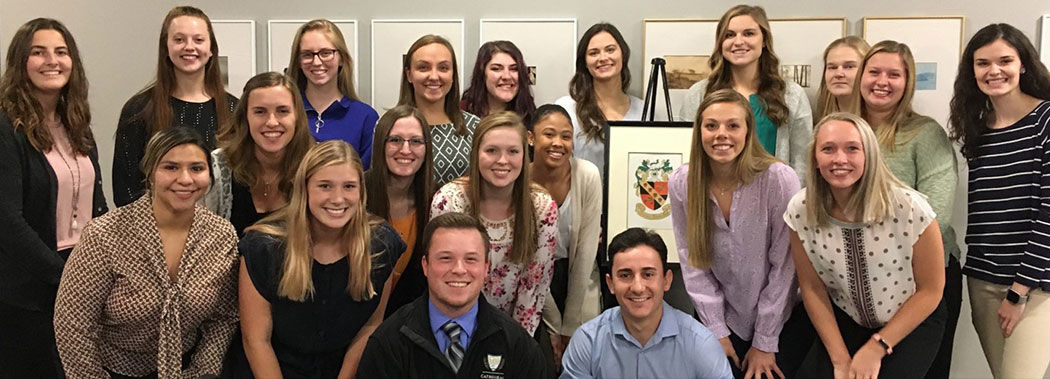
New BBB members include: Lexi Albert, Mariah Bell, Kayla Boettcher, Zachary Bracken, Monet Datari, McKenna Gaalswyk, Alyssa Haram, Samantha Henning, AnnMarie Jacobson, Daynalyn Jostock, Erin Lime, Graham Lorsung, Andrew Tepp, and Cole Van Houten.
It’s time to face reality about the future of artificial intelligence
According to research from International Data Corporation, revenues for big data and business analytics solutions are forecasted to reach $260 billion in 2022.
An increase in the use of artificial intelligence (AI) will result in $2.9 trillion of business value by 2030, according to a study by Gartner.
“Progressive thinking businesses and organizations cannot afford to ignore the growing applications of artificial intelligence (AI) and data analytics,” says Michael Ratajczyk, the program director for B.A. and M.S. Business Intelligence and Data Analytics programs at Saint Mary’s University of Minnesota. “Sometimes machines can do it better than humans. As people say, machines don’t sleep, they don’t take vacation, they don’t get sick, and they don’t go on camping trips. They do what they’re told, and a machine can do the work with far more precision — and without 20 years of training.”
AI is here to stay, and it will be up to businesses and humans to adapt, adopt, and adjust to the future — especially in the areas of agriculture, transportation, and healthcare, where there is great potential for growth.
“Businesses can’t afford to ignore AI to remain competitive, and students can’t afford to not keep up with AI trends either,” according to Ratajczyk. “Soon AI will be addressed in all business classes. It’s true that sometimes people can be replaced by machines, and that can be good for businesses and bad for employees. There will always be a need for those who can program AI software and prepare, analyze, interpret the data. And, importantly, there needs to be a balance between technology and the human touch.”
There’s a lot to learn about AI and how it will play a role in the very near future. So, if you are a reporter covering this topic — then let our experts help.
Ratajczyk works with both undergraduate and graduate business intelligence and data analytics students at Saint Mary’s University. He’s an expert in the field and is available to help with any of your coverage or questions. To book an interview with Ratajczyk, simply click on his profile link below and arrange a time.
Connect with:
Michael Ratajczyk, M.A.
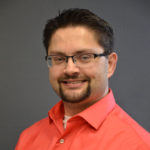 Assistant Professor, Business
Assistant Professor, Business
Program Director, B.S. and M.S. Business Intelligence and Data Analytics
Research Fellow for Artificial Intelligence Studies at Wiley Education Services
Expertise: Business intelligence and data analytics
View profile

Saint Mary’s ranks in top 3 for MBA program; business dean encourages higher ed to go beyond traditional education
In spite of being in a tough market, the Saint Mary’s University School of Business and Technology’s Master of Business Administration program has a top-3 ranking in Minnesota and Western Wisconsin, according to the newest rankings published on Dec. 6 in the Minneapolis/St. Paul Business Journal.
Furthermore, the rankings are packaged with a Q-and-A profile featuring Michelle Wieser, dean of Saint Mary’s School of Business and Technology, who talks about the challenges and opportunities of competing in today’s market for graduate students. She joined the Saint Mary’s community in August.
“We’re all fighting for a piece of the pie and that pie is getting smaller when you think about traditional education,” Wieser told the Business Journal. “It’s time for us to think beyond that into some really new areas — not just help make the university sustainable, but really fit what employers and students need.”
A letter from Father Burns to our community
On Friday afternoon, students at Saint Mary’s University of Minnesota gathered peacefully on our Winona Campus to speak out in support of their fellow students and against bias and exclusion. My colleagues and I are proud to see the love and concern they demonstrated, not only for their classmates but for the university they consider their home. This type of peaceful civil discourse, this willingness to stand up for what one believes is right, lies at the very core of what we believe in and teach at Saint Mary’s.
It is true that Saint Mary’s, as a Lasallian Catholic university, has faced challenges in a full expression of its vision to welcome and embrace all people of good will. We have stumbled at times. But each time we stumble, we learn: we listen and try to improve in all areas.
The desire to improve in all areas is born out in our strategic plan: Building a Future Full of Hope 2025. In January 2019, we launched the strategic planning process and invited students, faculty, and staff to share their thoughts and ideas related to the future of Saint Mary’s. In listening sessions and via surveys, we learned that a more visible and constructive approach to diversity and inclusion was a very important concern. For that reason, and because it is the right thing to do, the first of our five strategic goals (Living Our Lasallian Catholic Heritage) has a focus on universitywide diversity and inclusion. In this area, we are creating a vice president for Inclusion and Human Dignity. This role will help guide us in these efforts. We anticipate having that position filled by summer 2020. We listened, and we learned.
During the assembly, our students highlighted several events that have sparked their concern. Last spring, Saint Mary’s had considered making some reallocations to housing (as it does each year, based upon student demographics). The university has some same gender or same-sex housing by floor in the residence halls, and additional same gender or same-sex housing was proposed. When students expressed questions and concerns, listening sessions were held, and university officials opted to not make proposed changes based on this feedback.
Students also mentioned a speaker the university brought to campus, someone who made a comment about the LGBTQ community which made some attendees uncomfortable. I immediately sent out a communication to our Saint Mary’s community, in which I assured them that Saint Mary’s promotes and celebrates respect and unity in diversity including race, religion, and gender and that, at Saint Mary’s, we want to make sure that all members of the community find themselves welcome and secure as they pursue their educational dreams.
Our students were also disappointed in a change to a training activity planned by a student group, Serving Others United in Love (S.O.U.L.). A member of our Campus Ministry staff changed the destination of a S.O.U.L. leader training trip because there was a misunderstanding on what would happen as part of this trip regarding a proposed discussion about gender-neutral pronouns during the trip. We have had and will continue to have conversations with our staff and the affected students regarding the concerns this decision caused. We will do our best to accelerate the timeline for already planned diversity and inclusion training.
Further, what was a matter of following university protocol was misinterpreted by students as an act of censorship when posters promoting an LGBTQ gathering were removed. The posters in question were hung without gaining approval (which all posters must have, as required by university policy); once that approval was given, the posters were rehung.
I provide these explanations not as excuses, but as clear examples of our continued good faith and interest in serving our community to its fullest. Saint Mary’s is a microcosm of our broader society – a society in which changing demographics, expectations, and even vocabulary can lead to either great discord or, as we hope, to greater understanding and inclusion.
In the hopes that we can achieve that greater understanding and inclusion, I want to reaffirm that Saint Mary’s honors and respects the human dignity of all individuals. We celebrate inclusion and diversity. We welcome all members of our community. These are two principles core to our identity as a Lasallian Catholic university. This commitment endures regardless of whether one is a student of faith or not, and includes all people of good will of any and all races, genders, ethnicities, or sexual identities.
As an institution of higher learning, Saint Mary’s knows – I know – that we must continue to work through challenges, to engage in difficult conversations, and to encourage the type of intellectual discourse on sometimes difficult issues if we hope to fulfill our mission to awaken, nurture, and empower learners to ethical lives of service and leadership. This is why we will continue to strive to be a place where we can agree to disagree agreeably; where we will assume and encourage the good of each other; and where we respect each other’s perspective and remain open to all, even amidst our differences of opinion. We will continue to listen. We will continue to learn. And we will continue to believe in the living presence of God in our students, in our community, and in our world.
Sincerely,
![]()
Father James P. Burns, IVD, Ph.D.
President, Saint Mary’s University of Minnesota
Saint Mary’s musicians to perform at Watkins Great Hall
WINONA, Minn. — Saint Mary’s University chamber music ensembles will perform at the Watkins Manor Great Hall, 175 E Wabasha St., from 6 to 7 p.m. on Wednesday, Dec. 11. This free recital is open to the public. Residents of Watkins Manor are especially invited to enjoy the performance.
Ensembles will include a flute choir, clarinet quartet, euphonium/tuba quartet, string trio, mixed woodwind trio, and clarinet trio. Repertoire will include a variety of pieces by classical composers as well as some holiday arrangements.
For additional details, contact Dr. Janet Heukeshoven, chamber music coordinator, at jheukesh@smumn.edu.
